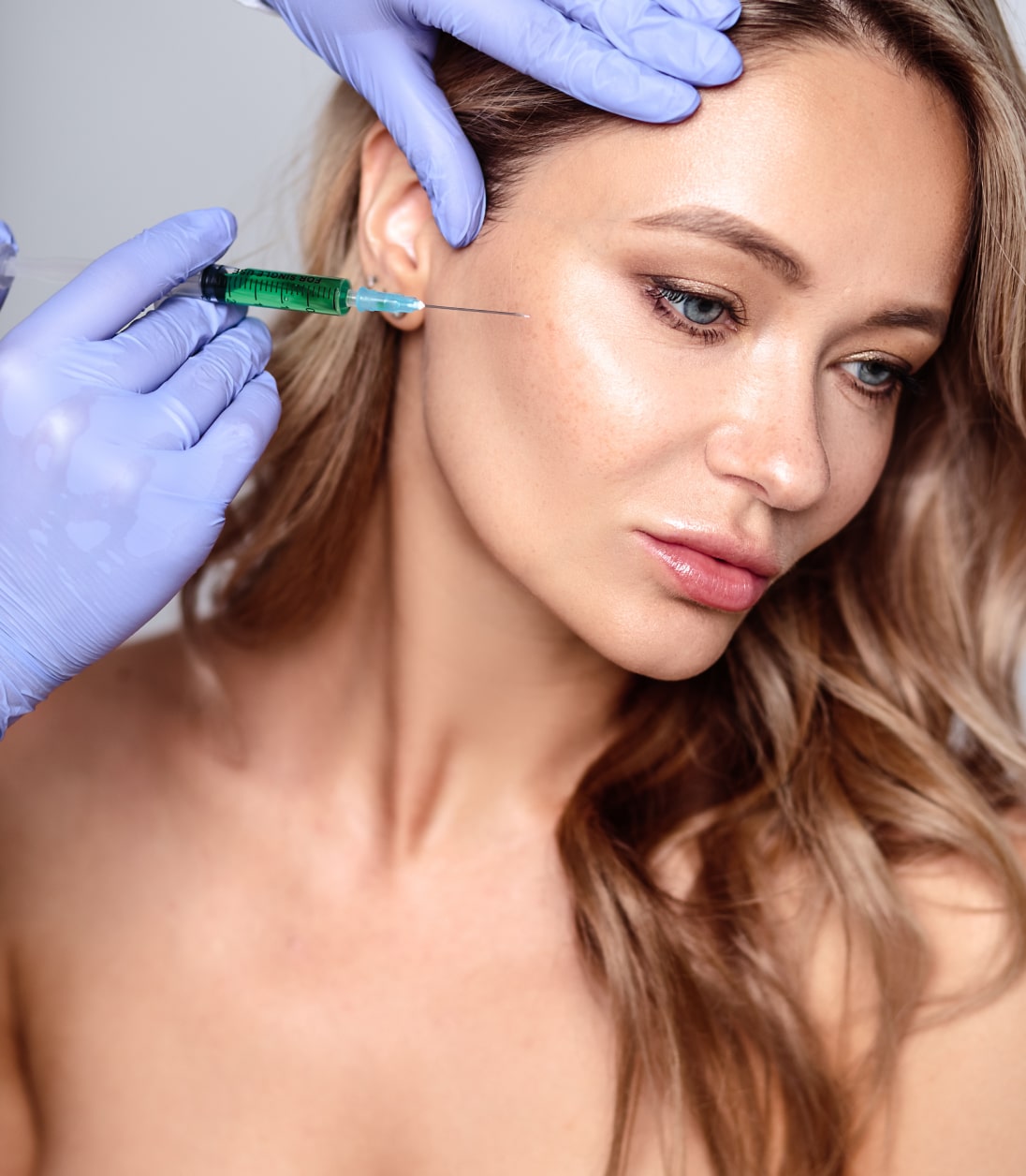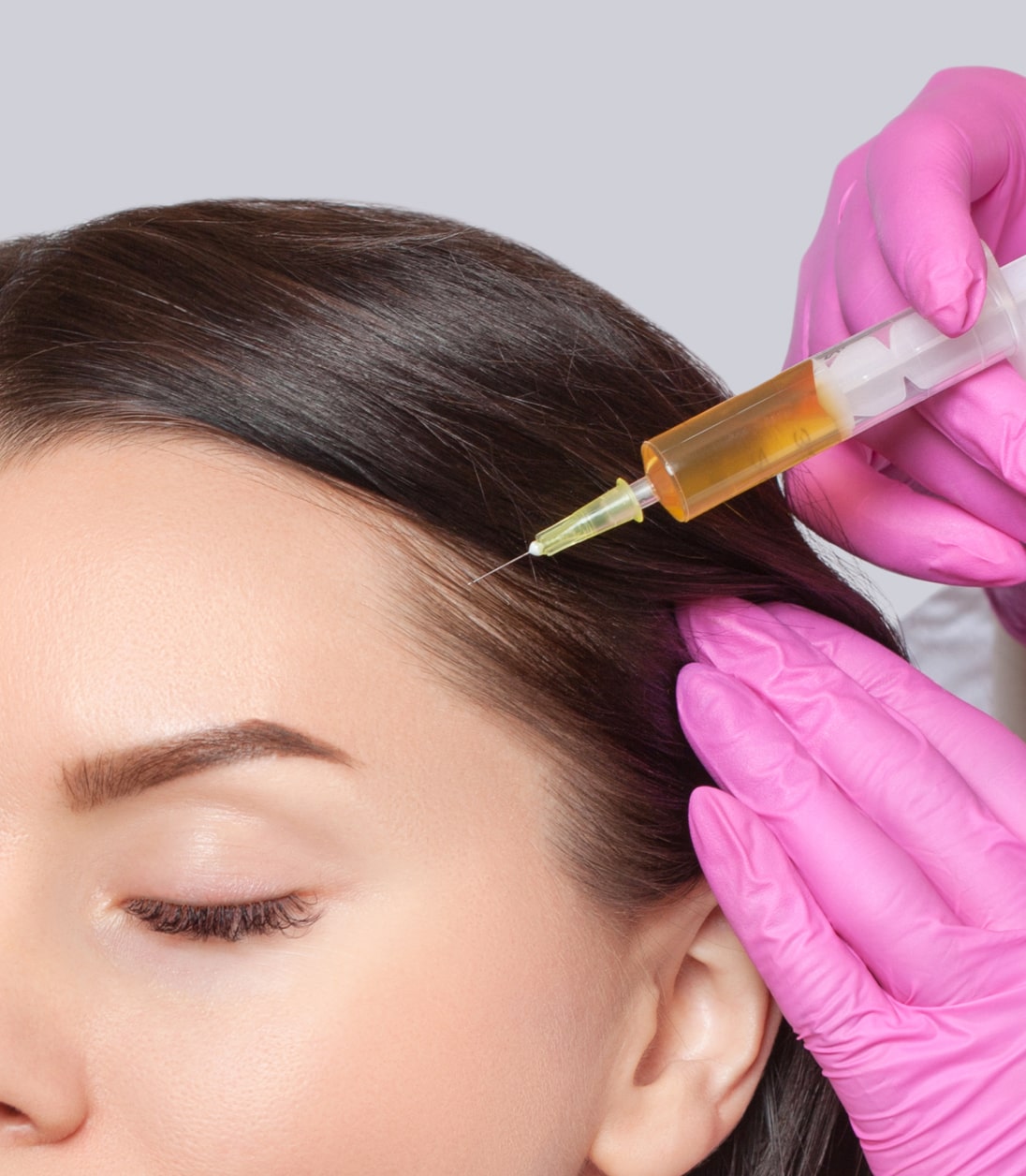FREE VIRTUAL CONSULTATIONS
- (786) 750-2355
Intimate Brightening
Skin is a funny thing. It takes on a mind of its own the older it gets, often displaying signs of discoloration, which is more like a story of the journey your skin has experienced over the years.
Some areas get lighter while others get darker. But regardless, there’s a way to brighten the skin to look fresh, youthful, and rejuvenated.

The skin on the face isn’t the only place privy to experiencing unwanted discoloration.
Similarly, the knees, inner thighs, and underarms can fall victim to excess pigment formation causing these areas of the body to appear darker than the surrounding skin. While there’s no medical problem with skin that’s somewhat darker than the rest, it’s bothersome and creates an uneven tone, giving reason enough to do something about it. If you wish to brighten areas of discoloration on the body, intimate brightening may be the procedure for you.

Why Discoloration Occurs
If the skin on your inner thighs, vaginal or anal area, knees, or underarms is darker than the rest of your body, you’re not alone.
No matter your age, ethnicity, skin type, or tone, darkened skin affects numerous people and is relatively common. While dark skin bears no medical or health implications, its appearance can be embarrassing, uncomfortable, and annoying. But just because one area of the skin appears darker than the rest doesn’t mean you should feel bad about your skin’s appearance (it’s beautiful, regardless!)
While it may seem like darkened skin pops up overnight, it doesn’t. Instead, it’s a long time in the making and occurs for one of the following reasons.
- Hyperpigmentation, which results from excess melanin production, is usually produced in the area due to increased hormones, or the skin has become thicker over time, giving way to a darkened effect. Hormonal changes, sun exposure, and medication can all cause hyperpigmentation.
- Friction occurs from repeatedly rubbing the skin repetitively, usually due to clothing. Obesity can also cause increased friction and put pressure on the skin.
- Certain skin conditions, like acanthosis nigricans and psoriasis which, cause discoloration
What Is Intimate Brightening?
Bothersome discoloration that affects the inner thighs, underarms, knees, and genital region can be treated.
Intimate brightening is a procedure that brightens and exfoliates darkened skin to appear brighter and more evenly toned. Some people wish to lighten these areas, especially the genital area, for various reasons. You can lighten both the vaginal area and anal areas (or just one) with the appropriate products and treatments.
Different skin-brightening and exfoliating ingredients and treatments are performed to lighten the skin, including unique skin-brightening creams or gels. An active ingredient that breaks up melanin, like kojic acid, arbutin, or hydroquinone, is necessary to lighten the skin effectively. Or in some cases, a special laser is often used along with a brightening treatment to create a lightening effect on the skin. When lasers are the preferred mechanism of action, fast-pulse technologies such as pico and nanosecond lasers are often utilized.
How Does Intimate Brightening Work?
Any time there is discoloration in the skin, no matter how large the affected area is or the level of darkness, it results from an overproduction of melanin, the pigment that gives skin its color.
In addition, various factors, including hormones, medications, trauma, weight, friction, and even sun exposure, can cause skin darkening.
Before treating discolored skin, it’s essential to identify what’s causing excess pigment. This way, the appropriate course of action can be devised, and if prevention methods need to be considered or implemented, they can be put into place.
Treating discoloration via intimate brightening isn’t as scary as it sounds, although a series of treatments are required to eradicate the unwanted color in the skin. Several topical therapies with pigment-deactivating and exfoliating properties are applied to the skin. Popular brightening agents include kojic acid, hydroquinone, and azelaic acid.
- Hydroquinone: This widely used brightening agent is effective in treating a wide variety of pigment. However, it can make the skin sensitive and dry and may cause irritation or peeling in some patients, so be sure to use this ingredient under medical supervision.
- Kojic acid: This popular depigmenting ingredient prevents melanin from forming in the skin and reduces existing melanin. Kojic acid is one of the safest lightening agents and acts as an antioxidant helping to limit inflammation.
- Azelaic acid: Like kojic acid, azelaic acid limits the amount of melanin in the skin by reducing inflammation.
In addition to topical formulas, professional treatments often incorporate exfoliation therapies and non-ablative laser treatments, which help break up existing pigment living in the skin by removing very thin layers of pigmented skin cells on the surface. With less pigment on the skin’s surface, it appears bright and lighter. Where the pigment lives in the skin (the dermal layers vs. the epidermis) dictates how it will be treated. For intimate brightening purposes, the most commonly used treatments include:
- Chemical peels: A professional form of exfoliation, chemical peels use a special mix of concentrated acids to remove the uppermost layer of skin that holds pigment gently yet effectively. Performed as a series of treatments, chemical peels can employ either a single acid or a mix of them to help improve pigmentation while rejuvenating the skin. However, some chemical peels can increase skin dryness and redness depending on the acid used, so always follow your provider's aftercare instructions.
- Microdermabrasion: Microdermabrasion can treat discoloration in areas where the skin is thicker, like the knees and elbows. This exfoliating treatment uses a diamond-tipped wand to gently buff away discoloration and reveal fresh, new, unpigmented skin underneath.
- Intense Pulsed Light (IPL): This light-based treatment targets melanin in the skin via a specific wavelength to break it up and lighten the skin.
- Lasers: For more stubborn pigment, laser treatment can reduce pigment from the skin. Like other modalities, lasers destroy melanin clusters to lighten and brighten discolored areas. Of all the treatment options, lasers are often thought to be the strongest.
What Are the Benefits of Intimate Brightening?
Patients bothered by or self-conscious of areas of the body and skin affected by hyperpigmentation find the benefits of intimate brightening insurmountable.
The most significant advantage of the treatment is increased self-confidence. When areas of the skin are no longer affected by a darkened appearance, patients experience a renewed sense of self-confidence and feel less embarrassed about specific body parts. This is especially the case when treating more intimate areas.
Since there are different options for treating skin discoloration, the flexibility benefit of choosing the right solution is also highly appreciated by many patients. Regardless of which one you choose, they are fast, easy, and effective with little downtime.
Some of the main benefits of intimate brightening include:
- Less discoloration on the knees, underarms, inner thighs, or intimate areas
- Increased self-confidence
- Improved skin texture
- Rejuvenated skin
When brightening and lightening the vagina and anus, the visible improvement—this less discoloration—are most beneficial to the patient. But for some patients, the renewed sense of self-security and improved self-confidence is what they appreciate about the procedure.

Who Is The Ideal Candidate For Intimate Brightening?
Intimate brightening is generally helpful for anyone who experiences areas of darkened skin or hyperpigmentation that is bothersome, no matter your skin tone.
Whether the discoloration is genetic, natural, or due to environmental factors or aging, most people are considered ideal candidates for treatment. Both men and women can benefit from the treatment.
Skin lightening is beneficial for those experiencing:
- Age-related discoloration
- Discoloration from a hormonal imbalance
- Changes to skin tone from pregnancy or birth control medications
- Extreme chafing, friction, or rubbing of the skin
Of course, before committing to an intimate brightening procedure, it’s best to schedule a consultation with our experienced staff to determine if the procedure is right for you. Having realistic expectations about the procedure and its results is always important.

What Areas Can Be Treated with Intimate Brightening?
Most patients choose intimate brightening to lighten unwanted discoloration from body parts that are embarrassing, bothersome, or a hindrance. This varies from patient to patient. However, the most commonly treated areas include:
- The inner thighs
- The knees
- The underarms
- The initiate regions like the vagina, vulva, and anus
How Much Does Intimate Brightening Cost?
The cost of intimate brightening varies from patient to patient. The final cost depends on the area(s) treated, the number of treatments necessary, any at-home products required for maximum results, and the technique used. To determine the price of your intimate brightening treatment, schedule a consultation today!
What Does an Intimate Brightening Procedure Feel Like?
It’s best to arrive at your appointment with clean skin and loose-fitting clothing. If you have an intimate area treated, you may be instructed to shave certain spots on the day of your treatment.
What you experience during a brightening procedure depends on the technique used. Some treatments can cause a warming sensation on the skin, while others may require topical anesthetic. For example, when using lasers, there may be a mild snapping or tingling sensation followed by heat within the skin. Cooling tips and devices like cold air or fans help alleviate discomfort. With peels, there may be a spicy feeling as the solution is applied to the skin and goes to work before it is neutralized.
What is the Recovery Like After Intimate Brightening?
The nice thing about intimate brightening treatments, which are quick and take about 30 to 60 minutes, is that there’s next to no downtime. You can get the treatment done and return to your regular schedule quickly.
If lasers are used to lighten discoloration, you’ll want to take special care of the treated area. Keep it moisturized since it may feel red, sensitive, itchy, or swollen. Cold compresses and over-the-counter pain medications can help with any potential discomfort.
It’s normal for the skin to appear red and temporarily flushed with intimacy brightening treatments. Since the skin is prone to environmental and sun damage post-treatment, avoiding sun exposure, tanning beds, and anything inflammatory to the skin is crucial. Sunscreen application daily in exposed areas is imperative.
The Results
The skin will be noticeably lighter after treatment, but the degree of lightening depends on skin type, how light you wish the discoloration to be, and how dark the pigmented area is.
Most patients are happy with the improved lightness.
To achieve the maximum results, it’s essential to follow through with the entire course of treatment, which generally consists of about four or more sessions every four to six weeks.
Frequently Asked Questions
Every patient is different, and some require more treatment sessions than others. The location of your discoloration, how dark the skin is, your natural skin tone, and your skin condition can influence the number of treatments you’ll benefit from. We recommend a consultation with our skilled and experienced staff to determine how many treatments you’ll need.
For the most part, any erased discoloration should remain that way, but it’s impossible to predict results. If the underlying cause of the discoloration is not identified, some of the discoloration can return. It’s also essential to keep the treated areas free of unnecessary sun damage and other potentially damaging factors. Touch-up sessions may be necessary to uphold the results.
The discoloration on my skin isn't new and has been there for years. Will intimate brightening work?
Brightening treatments are effective on skin with discoloration or hyperpigmentation, whether fresh and new or has been there for some time. To best determine how you’ll benefit from intimate brightening, we recommend scheduling a consultation first with a member of our staff.
All aesthetic treatments and procedures have some risk and potential side effects, although they are rare with intimate brightening treatments. Some people may experience temporary minor redness, swelling, and discomfort.
When treating the vagina, vulva, or anus, there is the unlikely risk of discomfort, itching, temporarily painful intercourse, scabbing, or an unbalanced vaginal flora.
Intimate bleaching is extremely safe if it is performed under the watchful eye of a skilled and licensed provider. The treatment is quick, and there’s no need to worry about safety issues.
Are you Ready to Experience the AFL Beauty Bar Difference?
If you’re ready to eliminate unwanted discoloration and get the skin of your dreams, there’s no better time to book a consultation with AFL Beauty Bar. A one-on-one consultation with our experienced, certified team of skin experts will determine the best intimate brightening treatment for you. We can customize a unique package specific to your skin to achieve the best results possible. Click the button below to schedule a consultation or book your intimate brightening appointment today!

Contact Us
- aflbeautybar@gmail.com
- (786) 750-2355
-
51-53 NE 24th St Suite 107
Miami FL 33137
Copyright © 2023 AFL Beauty Bar. All rights reserved
Powered by Plastix Marketing









